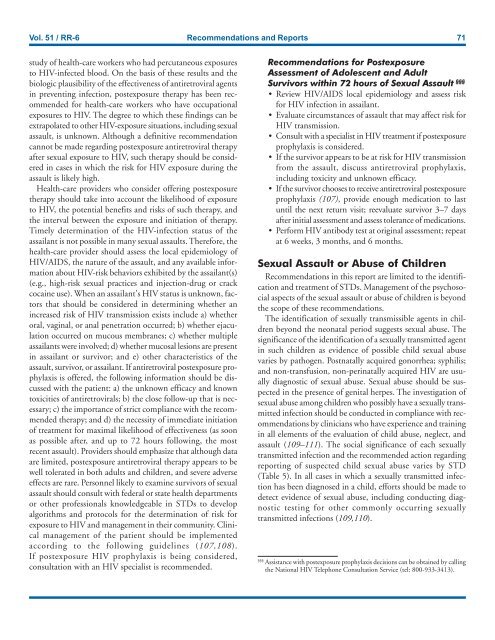You also want an ePaper? Increase the reach of your titles
YUMPU automatically turns print PDFs into web optimized ePapers that Google loves.
Vol. 51 / RR-6 Recommendations and Reports 71<br />
study of health-care workers who had percutaneous exposures<br />
to HIV-infected blood. On the basis of these results and the<br />
biologic plausibility of the effectiveness of antiretroviral agents<br />
in preventing infection, postexposure therapy has been recommended<br />
for health-care workers who have occupational<br />
exposures to HIV. The degree to which these findings can be<br />
extrapolated to other HIV-exposure situations, including sexual<br />
assault, is unknown. Although a definitive recommendation<br />
cannot be made regarding postexposure antiretroviral therapy<br />
after sexual exposure to HIV, such therapy should be considered<br />
in cases in which the risk for HIV exposure during the<br />
assault is likely high.<br />
Health-care providers who consider offering postexposure<br />
therapy should take into account the likelihood of exposure<br />
to HIV, the potential benefits and risks of such therapy, and<br />
the interval between the exposure and initiation of therapy.<br />
Timely determination of the HIV-infection status of the<br />
assailant is not possible in many sexual assaults. Therefore, the<br />
health-care provider should assess the local epidemiology of<br />
HIV/AIDS, the nature of the assault, and any available information<br />
about HIV-risk behaviors exhibited by the assailant(s)<br />
(e.g., high-risk sexual practices and injection-drug or crack<br />
cocaine use). When an assailant’s HIV status is unknown, factors<br />
that should be considered in determining whether an<br />
increased risk of HIV transmission exists include a) whether<br />
oral, vaginal, or anal penetration occurred; b) whether ejaculation<br />
occurred on mucous membranes; c) whether multiple<br />
assailants were involved; d) whether mucosal lesions are present<br />
in assailant or survivor; and e) other characteristics of the<br />
assault, survivor, or assailant. If antiretroviral postexposure prophylaxis<br />
is offered, the following information should be discussed<br />
with the patient: a) the unknown efficacy and known<br />
toxicities of antiretrovirals; b) the close follow-up that is necessary;<br />
c) the importance of strict compliance with the recommended<br />
therapy; and d) the necessity of immediate initiation<br />
of treatment for maximal likelihood of effectiveness (as soon<br />
as possible after, and up to 72 hours following, the most<br />
recent assault). Providers should emphasize that although data<br />
are limited, postexposure antiretroviral therapy appears to be<br />
well tolerated in both adults and children, and severe adverse<br />
effects are rare. Personnel likely to examine survivors of sexual<br />
assault should consult with federal or state health departments<br />
or other professionals knowledgeable in STDs to develop<br />
algorithms and protocols for the determination of risk for<br />
exposure to HIV and management in their community. Clinical<br />
management of the patient should be implemented<br />
according to the following guidelines (107,108).<br />
If postexposure HIV prophylaxis is being considered,<br />
consultation with an HIV specialist is recommended.<br />
Recommendations for Postexposure<br />
Assessment of Adolescent and Adult<br />
Survivors within 72 hours of Sexual Assault §§§<br />
Review HIV/AIDS local epidemiology and assess risk<br />
for HIV infection in assailant.<br />
Evaluate circumstances of assault that may affect risk for<br />
HIV transmission.<br />
Consult with a specialist in HIV treatment if postexposure<br />
prophylaxis is considered.<br />
If the survivor appears to be at risk for HIV transmission<br />
from the assault, discuss antiretroviral prophylaxis,<br />
including toxicity and unknown efficacy.<br />
If the survivor chooses to receive antiretroviral postexposure<br />
prophylaxis (107), provide enough medication to last<br />
until the next return visit; reevaluate survivor 3–7 days<br />
after initial assessment and assess tolerance of medications.<br />
Perform HIV antibody test at original assessment; repeat<br />
at 6 weeks, 3 months, and 6 months.<br />
Sexual Assault or Abuse of Children<br />
Recommendations in this report are limited to the identification<br />
and treatment of STDs. Management of the psychosocial<br />
aspects of the sexual assault or abuse of children is beyond<br />
the scope of these recommendations.<br />
The identification of sexually transmissible agents in children<br />
beyond the neonatal period suggests sexual abuse. The<br />
significance of the identification of a sexually transmitted agent<br />
in such children as evidence of possible child sexual abuse<br />
varies by pathogen. Postnatally acquired gonorrhea; syphilis;<br />
and non-transfusion, non-perinatally acquired HIV are usually<br />
diagnostic of sexual abuse. Sexual abuse should be suspected<br />
in the presence of genital herpes. The investigation of<br />
sexual abuse among children who possibly have a sexually transmitted<br />
infection should be conducted in compliance with recommendations<br />
by clinicians who have experience and training<br />
in all elements of the evaluation of child abuse, neglect, and<br />
assault (109–111). The social significance of each sexually<br />
transmitted infection and the recommended action regarding<br />
reporting of suspected child sexual abuse varies by STD<br />
(Table 5). In all cases in which a sexually transmitted infection<br />
has been diagnosed in a child, efforts should be made to<br />
detect evidence of sexual abuse, including conducting diagnostic<br />
testing for other commo<strong>nl</strong>y occurring sexually<br />
transmitted infections (109,110).<br />
§§§ Assistance with postexposure prophylaxis decisions can be obtained by calling<br />
the National HIV Telephone Consultation Service (tel: 800-933-3413).


